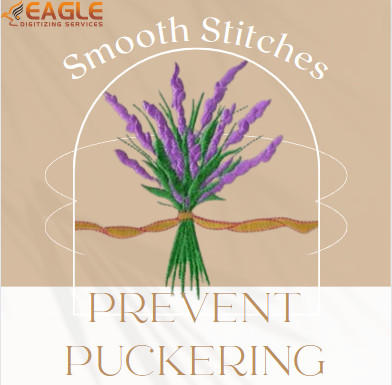How to Prevent Puckering in Your Embroidery Projects
Embroidery is an art form that requires precision and attention to detail. However, one common frustration that many embroiderers encounter is puckering, where the fabric wrinkles or gathers during the stitching process, resulting in unsightly imperfections. In this article, we'll explore various techniques and strategies to help you achieve smooth stitches and prevent puckering in your embroidery projects.
Characteristics
of Suitable Fabrics
The fabric you choose plays a crucial role in the outcome of your embroidery project. Opt for fabrics with stable weaves such as cotton, linen, or twill, as they provide a sturdy base for stitches. These fabrics have a tighter weave, which helps prevent puckering and ensures clean, crisp embroidery.
Avoiding
Fabrics Prone to Puckering
Certain fabrics are more prone to puckering than others due to their stretchiness or delicate fibers. Fabrics like silk or satin may look luxurious but can be challenging to embroider without experiencing puckering. Avoid fabrics with excessive stretch or delicate fibers, and opt for more stable options to minimize the risk of puckering.
Importance
of Proper Hooping
Proper hooping is essential for achieving smooth stitches and preventing puckering in your embroidery projects. When fabric is hooped too tightly or loosely, it can cause distortion and uneven stitching. Ensuring the fabric is taut and evenly stretched within the embroidery hoop is key to achieving professional-looking results.
Steps
for Correct Hooping
Start by placing the inner hoop on a flat surface and laying your fabric over it. Then, gently place the outer hoop over the fabric, making sure it sits evenly on top of the inner hoop. Tighten the screw on the outer hoop to secure the fabric in place, ensuring it is stretched evenly without any wrinkles or puckers. Adjust the tension as needed to achieve the desired tautness.
Understanding
Stabilizers and Their Role
Stabilizers are essential tools in embroidery that help support the fabric during stitching and prevent puckering. They come in various forms, including tear-away, cut-away, and water-soluble stabilizers, each serving a specific purpose. Understanding the role of stabilizers and choosing the right type for your fabric and design is crucial for achieving smooth stitches.
Matching
Stabilizers to Fabric and Design
Consider the weight and stretchiness of your fabric, as well as the complexity of your design, when selecting a stabilizer. Heavier fabrics may require a sturdier stabilizer to provide adequate support, while delicate fabrics may benefit from a lighter, more flexible stabilizer. Experiment with different types of stabilizers to find the perfect match for your embroidery project.
Importance
of Needle and Thread Quality
The quality of your needle and thread can significantly impact the outcome of your embroidery project. Using high-quality needles and threads ensures smooth stitching and reduces the risk of puckering. Invest in needles specifically designed for embroidery, as they have a sharper point and a larger eye to accommodate thicker embroidery threads.
Choosing
the Right Needle and Thread for the Fabric
Consider the weight and composition of your fabric when selecting a needle and thread. For heavier fabrics, choose a thicker needle and thread to penetrate the fabric more easily. Lighter fabrics may require a finer needle and thread to prevent puckering and distortion. Experiment with different needle and thread combinations to find the perfect match for your embroidery project.
Impact
of Tension on Stitch Quality
Tension plays a crucial role in stitch formation and can affect the appearance of your embroidery. Too much tension can cause the fabric to pucker, while too little tension can result in loose, uneven stitches. Adjusting the tension settings on your embroidery machine is key to achieving smooth, consistent stitches.
How to
Adjust Tension for Smooth Stitches
Start by testing the tension settings on a scrap piece of fabric to determine the ideal tension for your project. Make small adjustments to the tension dial and observe how it affects the stitches. Aim for a balanced tension where the stitches lay flat on the fabric without pulling or puckering. Remember to re-adjust the tension as needed throughout your embroidery project to maintain optimal stitch quality.
Importance
of Proper Stitching Techniques
Mastering proper stitching techniques is essential for achieving smooth, even stitches in your embroidery projects. Maintain a steady stitching speed and avoid abrupt starts and stops, which can cause distortion and puckering. Practice consistent stitch lengths and directions to create uniformity in your embroidery.
Tips
for Achieving Even Stitches
Use a light touch when guiding the fabric through the embroidery machine to prevent unnecessary tension and distortion. Keep an eye on the fabric as it stitches, making adjustments as needed to ensure smooth, even stitches. Practice patience and precision, as achieving flawless embroidery requires attention to detail and careful craftsmanship.
Importance
of Well-Digitized Designs
The quality of your embroidery design can impact the outcome of your project, including the risk of puckering. Well-digitized designs with proper stitch densities and underlay provide a solid foundation for smooth, professional-looking embroidery. Choose designs that are optimized for your fabric and machine to minimize the risk of puckering and achieve optimal results.
Tips
for Handling Intricate Designs
Handle intricate embroidery designs with care to prevent distortion and puckering. Use embroidery software to preview and edit designs before stitching to ensure they are compatible with your fabric and machine. Consider breaking complex designs into smaller sections to make stitching more manageable and reduce the risk of puckering. Practice good thread management to minimize thread buildup and maintain stitch quality throughout your embroidery project.
Regular
Cleaning and Oiling
Maintaining your embroidery machine is essential for optimal performance and stitch quality. Regularly clean and oil your machine according to the manufacturer's instructions to prevent the buildup of lint and debris that can affect stitching. Pay special attention to areas where thread and fabric accumulate, such as the bobbin case and needle plate, and remove any debris with a small brush or compressed air.
Checking
Machine Settings and Calibration
Periodically check your embroidery machine settings and calibration to ensure they are accurate and properly aligned. Check the tension settings, needle position, and hoop alignment to ensure they are set correctly for your fabric and design. Calibrate your machine as needed to maintain consistent stitch quality and prevent puckering in digitizing embroidery.
Inspecting
Finished Work for Puckering
Once you've completed your embroidery project, inspect the finished work for any signs of puckering or imperfections. Check the front and back of the fabric for uneven stitches or areas of distortion. If puckering occurs, assess the potential causes and make adjustments to prevent it from happening in future projects.
Troubleshooting
Common Issues and Solutions
If you encounter puckering or other issues during the embroidery process, don't panic. Take a step back and assess the situation calmly. Check your tension settings, hooping technique, and fabric selection to identify potential causes of the problem. Make adjustments as needed and continue stitching, keeping an eye on the fabric to ensure smooth, even stitches. With practice and patience, you'll become adept at troubleshooting and preventing puckering in your embroidery projects.
Preventing puckering in your embroidery projects
requires a combination of proper technique, careful attention to detail, and
thoughtful craftsmanship. By choosing the right fabric, mastering the hooping
technique, using stabilizers effectively, selecting quality needles and
threads, adjusting tension settings, practicing proper stitching techniques,
handling embroidery designs with care, maintaining your embroidery machine, and
troubleshooting common issues, you can achieve smooth stitches and
professional-looking results in your embroidery projects. With practice and
perseverance, you'll soon be creating flawless embroidery that's free from
puckering and other imperfections. For the best digitizing service, please feel free to contact us.



